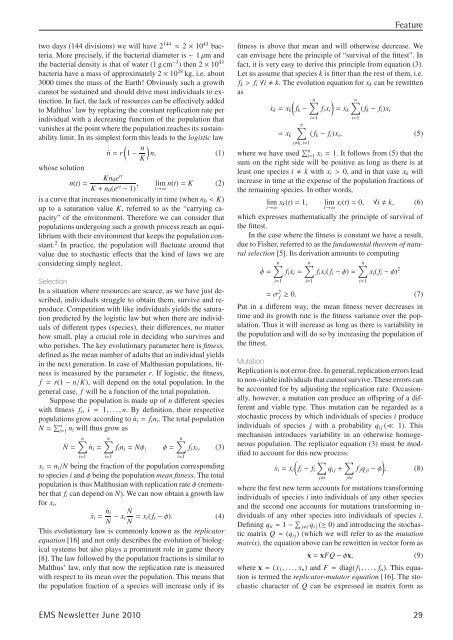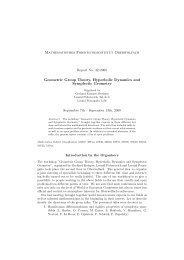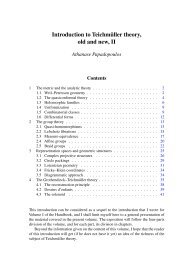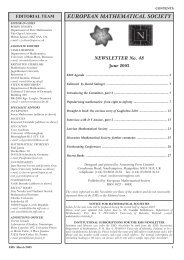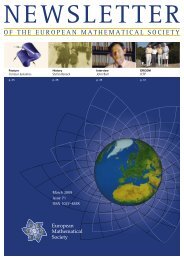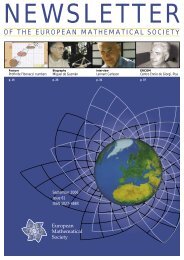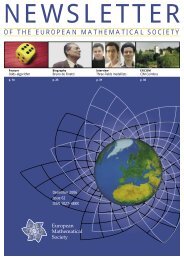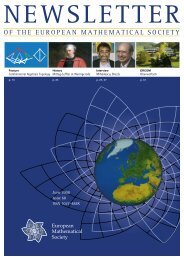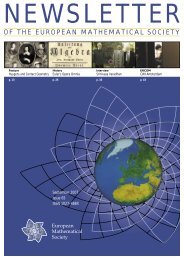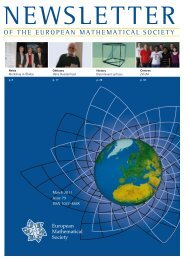EMS Newsletter June 2010 - European Mathematical Society ...
EMS Newsletter June 2010 - European Mathematical Society ...
EMS Newsletter June 2010 - European Mathematical Society ...
You also want an ePaper? Increase the reach of your titles
YUMPU automatically turns print PDFs into web optimized ePapers that Google loves.
two days (144 divisions) we will have 2144 ≈ 2 × 1043 bacteria.<br />
More precisely, if the bacterial diameter is ∼ 1 μm and<br />
the bacterial density is that of water (1 g cm−3 )then2× 1043 bacteria have a mass of approximately 2 × 1028 kg, i.e. about<br />
3000 times the mass of the Earth! Obviously such a growth<br />
cannot be sustained and should drive most individuals to extinction.<br />
In fact, the lack of resources can be effectively added<br />
to Malthus’ law by replacing the constant replication rate per<br />
individual with a decreasing function of the population that<br />
vanishes at the point where the population reaches its sustainability<br />
limit. In its simplest form this leads to the logistic law<br />
�<br />
˙n = r 1 − n<br />
�<br />
n, (1)<br />
K<br />
whose solution<br />
Kn0e<br />
n(t) =<br />
rt<br />
K + n0(ert , lim n(t) = K (2)<br />
− 1) t→∞<br />
is a curve that increases monotonically in time (when n0 < K)<br />
up to a saturation value K, referred to as the “carrying capacity”<br />
of the environment. Therefore we can consider that<br />
populations undergoing such a growth process reach an equilibrium<br />
with their environment that keeps the population constant.<br />
2 In practice, the population will fluctuate around that<br />
value due to stochastic effects that the kind of laws we are<br />
considering simply neglect.<br />
Selection<br />
In a situation where resources are scarce, as we have just described,<br />
individuals struggle to obtain them, survive and reproduce.<br />
Competition with like individuals yields the saturation<br />
predicted by the logistic law but when there are individuals<br />
of different types (species), their differences, no matter<br />
how small, play a crucial role in deciding who survives and<br />
who perishes. The key evolutionary parameter here is fitness,<br />
defined as the mean number of adults that an individual yields<br />
in the next generation. In case of Malthusian populations, fitness<br />
is measured by the parameter r. If logistic, the fitness,<br />
f = r(1 − n/K), will depend on the total population. In the<br />
general case, f will be a function of the total population.<br />
Suppose the population is made up of n different species<br />
with fitness fi, i = 1,...,n. By definition, their respective<br />
populations grow according to ˙ni = fini. The total population<br />
N = �n i=1 ni will thus grow as<br />
n� n�<br />
n�<br />
˙N = ˙ni = fini = Nφ, φ = fixi, (3)<br />
i=1<br />
i=1<br />
xi = ni/N being the fraction of the population corresponding<br />
to species i and φ being the population mean fitness. The total<br />
population is thus Malthusian with replication rate φ (remember<br />
that fi can depend on N). We can now obtain a growth law<br />
for xi,<br />
˙xi = ˙ni ˙N<br />
− xi<br />
N N = xi( fi − φ). (4)<br />
This evolutionary law is commonly known as the replicator<br />
equation [16] and not only describes the evolution of biological<br />
systems but also plays a prominent role in game theory<br />
[8]. The law followed by the population fractions is similar to<br />
Malthus’ law, only that now the replication rate is measured<br />
with respect to its mean over the population. This means that<br />
the population fraction of a species will increase only if its<br />
i=1<br />
Feature<br />
fitness is above that mean and will otherwise decrease. We<br />
can envisage here the principle of “survival of the fittest”. In<br />
fact, it is very easy to derive this principle from equation (3).<br />
Let us assume that species k is fitter than the rest of them, i.e.<br />
fk > fi ∀i � k. The evolution equation for xk can be rewritten<br />
as<br />
� n� � n�<br />
˙xk = xk fk − fixi = xk ( fk − fi)xi<br />
<strong>EMS</strong> <strong>Newsletter</strong> <strong>June</strong> <strong>2010</strong> 29<br />
= xk<br />
n�<br />
i�k, i=1<br />
i=1<br />
i=1<br />
( fk − fi)xi, (5)<br />
where we have used �n i=1<br />
xi = 1. It follows from (5) that the<br />
sum on the right side will be positive as long as there is at<br />
least one species i � k with xi > 0, and in that case xk will<br />
increase in time at the expense of the population fractions of<br />
the remaining species. In other words,<br />
lim<br />
t→∞ xk(t) = 1, lim xi(t) = 0, ∀i � k, (6)<br />
t→∞<br />
which expresses mathematically the principle of survival of<br />
the fittest.<br />
In the case where the fitness is constant we have a result,<br />
due to Fisher, referred to as the fundamental theorem of natural<br />
selection [5]. Its derivation amounts to computing<br />
n� n�<br />
n�<br />
˙φ = fi ˙xi = fixi( fi − φ) = xi( fi − φ) 2<br />
i=1<br />
i=1<br />
= σ 2 f ≥ 0. (7)<br />
Put in a different way, the mean fitness never decreases in<br />
time and its growth rate is the fitness variance over the population.<br />
Thus it will increase as long as there is variability in<br />
the population and will do so by increasing the population of<br />
the fittest.<br />
Mutation<br />
Replication is not error-free. In general, replication errors lead<br />
to non-viable individuals that cannot survive. These errors can<br />
be accounted for by adjusting the replication rate. Occasionally,<br />
however, a mutation can produce an offspring of a different<br />
and viable type. Thus mutation can be regarded as a<br />
stochastic process by which individuals of species i produce<br />
individuals of species j with a probability qij(� 1). This<br />
mechanism introduces variability in an otherwise homogeneous<br />
population. The replicator equation (3) must be mod-<br />
ified to account for this new process:<br />
� � �<br />
˙xi = xi fi − fi qij +<br />
j�i<br />
j�i<br />
i=1<br />
�<br />
f jq ji − φ , (8)<br />
where the first new term accounts for mutations transforming<br />
individuals of species i into individuals of any other species<br />
and the second one accounts for mutations transforming individuals<br />
of any other species into individuals of species i.<br />
Defining qii = 1 − � j�i qij(≥ 0) and introducing the stochastic<br />
matrix Q = (qij) (which we will refer to as the mutation<br />
matrix), the equation above can be rewritten in vector form as<br />
˙x = xFQ − φx, (9)<br />
where x = (x1,...,xn) and F = diag( f1,..., fn). This equation<br />
is termed the replicator-mutator equation [16]. The stochastic<br />
character of Q can be expressed in matrix form as


